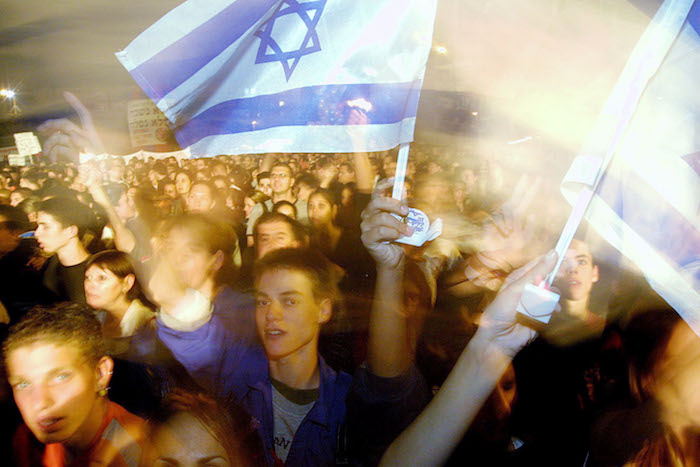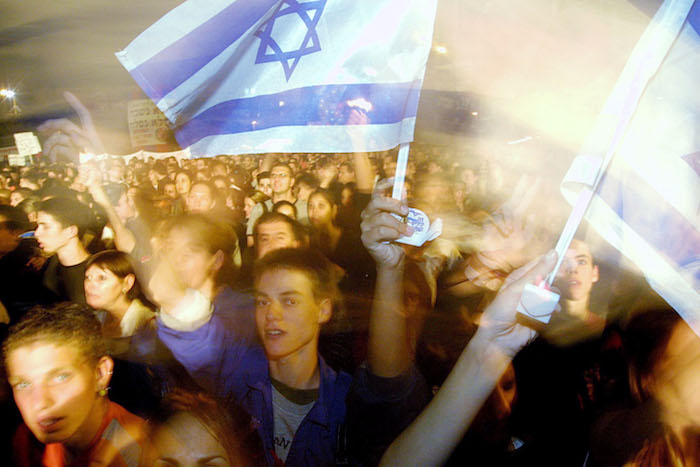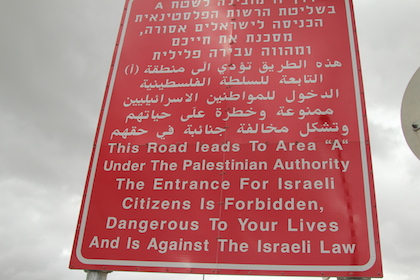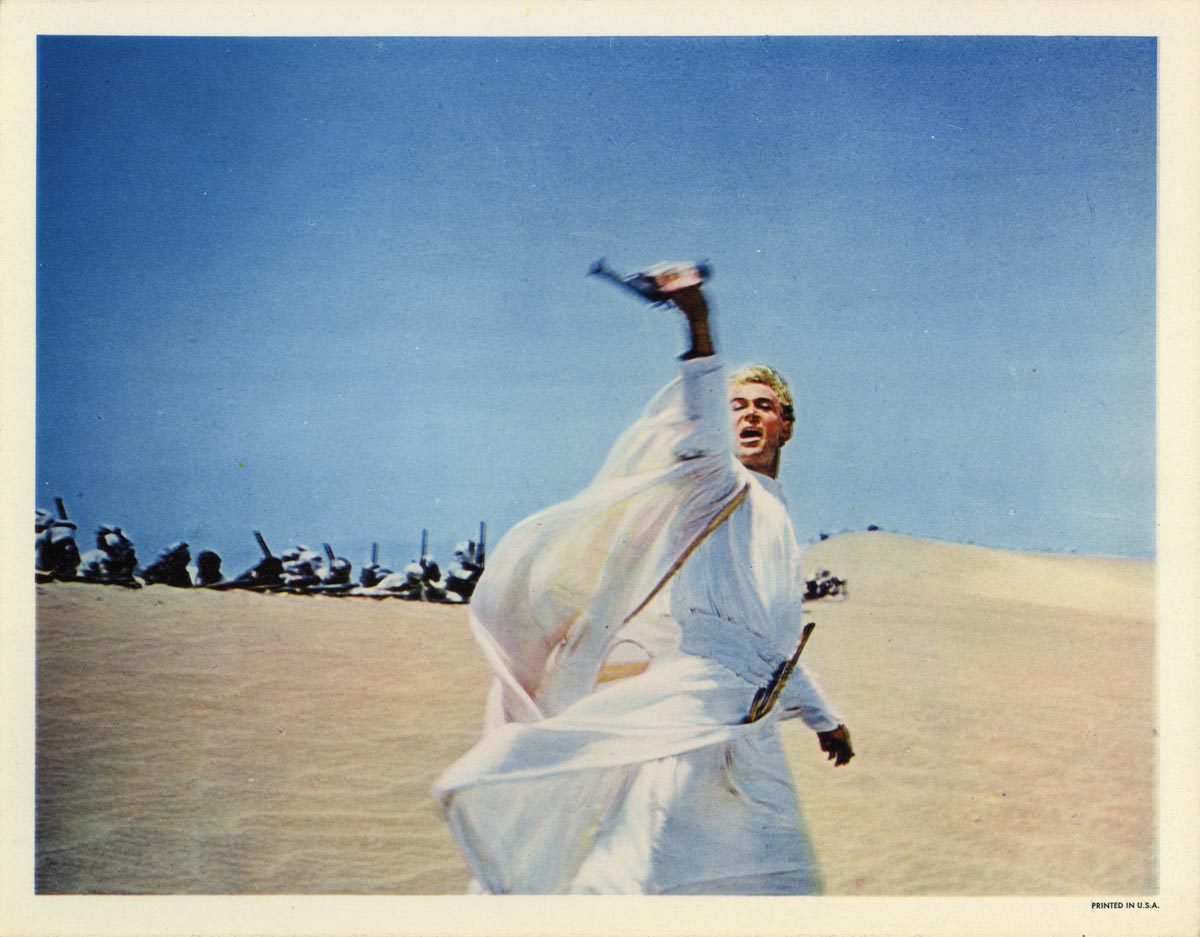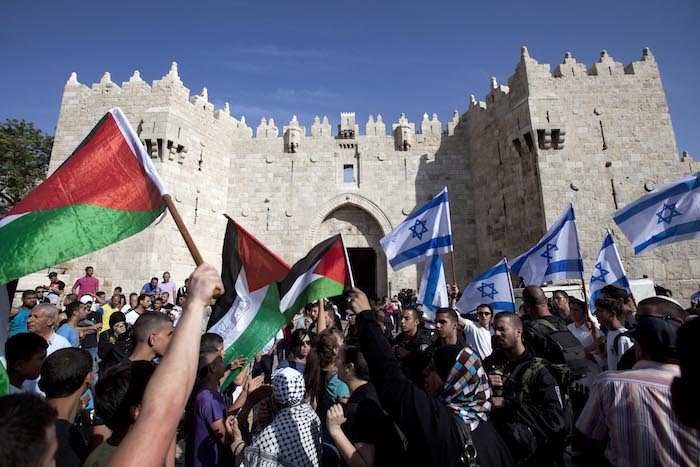These words are printed in three languages, loud and clear, on big red signs beside Israeli roads leading to Palestinian-governed territories:
This road leads to Area “A” under the Palestinian Authority. Entry for Israeli citizens is forbidden, life-threatening, and against Israeli law.
The warning is unlikely to shock anyone familiar with Israel today. As those of us who live here know all too well, a trip inside one of these areas can indeed prove fatal.
Yet the term “Israeli citizens” belies a deeply unsettling truth: not all Israelis need avoid entering these areas. Israeli Arabs come and go freely, and are even encouraged to conduct business in the territories. Only Jewish Israelis are at risk of death. No less unsettling is that one encounters such signs not at distant outposts, far from densely populated Jewish towns, but on the fringes of Jerusalem and the outskirts of Tel Aviv, just a few miles from Ben-Gurion International Airport.
Israeli Jews have resigned themselves to this reality. Under the laws of our own government, areas within what we consider our ancient national homeland are simply off-limits to Jews. We are not taken aback by this circumstance, not even disturbed. When the Palestinian Authority names central streets after suicide bombers with Jewish blood on their hands, we don’t think twice about it. And when we talk about a Palestinian state, we take it for granted that Jews will not be allowed to live there—or that, if allowed, they would never feel safe enough to do so.
To be sure, in the latest round of negotiations headed by U.S. Secretary of State John Kerry, all sorts of suggestions have been floated for normalizing relations between Israelis and Palestinians. At the end of January, Prime Minister Benjamin Netanyahu went so far as to raise the prospect of Jewish settlers having the right to remain in a future Palestinian state. But the outcry of protest from his own coalition partners, together with the longstanding stony refusal of Palestinian leaders even to consider the notion of a single Israeli Jew living in their prospective state, has only underlined the grotesque abnormality of our situation.
Correcting this fundamental abnormality is what lies behind Netanyahu’s repeated demand that the Palestinians recognize Israel as the Jewish state. Maintaining it in place is what lies behind their repeated rejection of the same demand. This—not territory—is the essence of the conflict. Just as the very existence of a sovereign Jewish state in the Middle East has been the root cause of the long-running Arab war against that state, accepting its existence will be the root cause of any future peace.
Unfortunately, we Israelis have stopped hoping for such a peace. In the disastrous aftermath of the Oslo accords, having awakened from a false dream, we have become realistic. We don’t talk much about peace—tellingly, what in the 1990s was called the “peace process” is now routinely referred to as the “political process”—and even when we use the term, we mean something different by it. We speak not of Arab acceptance of our legitimacy and our national aspirations but of how to arrange affairs so that the Jewish state can be kept safe, and the conflict confined. The hope that our neighbors will put aside their animosity and accept our presence here as right and natural—the hope, that is, for true peace—is something we have abandoned.
In doing so, we have also lost something that is key to our sense of ourselves, and to our future.
1. The Phone Call That Never Came
The Hebrew word for peace, shalom, entails more than the absence of violence; the verb from which it is derived means to complete an action, and the term itself connotes wellbeing and tranquility. In the Bible, shalom is the stage that follows victory. Once the Israelites repulse their enemies and are able to “dwell in the land safely,” they will also be blessed with “peace in the land” (Leviticus 26:5-6). King David is forced to fight wars throughout his life, but receives God’s promise that his son will reap the benefits: “I will give him rest from all his enemies all around . . . and confer peace [shalom] and quiet on Israel” (1 Chronicles 22:9).
Thus, the original Hebrew definition of peace involves more than a cessation of hostilities. Peace is the state in which one’s neighbors and rivals recognize that one’s presence is a fact and start cooperating instead of fighting.
This was the original Zionist vision as well. Even those who acknowledged that the Jewish homeland could not be built without bloodshed looked forward to the day when Israel would become a steady reality, accepted by all of its neighbors. Indeed, when the state of Israel was established, “in the very midst of the onslaught launched against us now for months” (in the words of the 1948 declaration of independence), the new government took pains to “extend our hand to all neighboring states and their peoples in an offer of peace and good neighborliness.” The declaration proceeded to visualize the days after the war, when the young state would “do its share in a common effort for the advancement of the entire Middle East.”
At the time, few if any Zionists foresaw the Jewish state as a permanently isolated enclave, under unremitting threat from hostile neighbors. The image of “a villa in the jungle,” in the vivid coinage of former Prime Minister Ehud Barak, was emphatically not the Zionist dream. Instead, surveying the Middle East, the early Zionists saw the potential of a regional transformation, effectuated through cooperative efforts by Jews and Arabs together. Theodor Herzl inscribed this vision in his fictionalized Altneuland (1902), picturing the Arab residents of Palestine as proud future citizens of the Zionist state. A half-century later, David Ben-Gurion reiterated the same vision, extolling Israel’s promise of bringing comity and prosperity to all.
History, of course, proved otherwise. Arab opposition to a Jewish homeland, strong from the beginning, proved unrelenting. In response, the Zionist movement eventually adopted Vladimir (Zev) Jabotinsky’s “Iron Wall” strategy: forge ahead, abandon vain efforts at appeasement, and build up the strength of the state against the day when none could dispute its permanence and there would be no choice but to accept it.
The Jewish state’s resounding victory in the Six-Day War of June 1967 convinced many Israelis that that longed-for day had come. Seven years earlier, Egyptian President Gamal Abdel Nasser had proclaimed to the UN General Assembly that the “only solution” to the Arab-Israeli conflict was “the annulment of Israel.” But now, so sweeping was the young state’s lightning triumph over the massed forces of Egypt, Syria, and Jordan that in the aftermath it didn’t even seem necessary to draw up peace proposals. A full and genuine peace seemed inevitable: “Tomorrow,” in the words of a wildly popular song by Naomi Shemer, “we will maybe sail/ from Eilat to the ivory coast; and on the old destroyers/ golden oranges will be loaded.” Moshe Dayan, then minister of defense, said he was waiting for a phone call.
But the phone call never came. Instead, that same summer, the Arab League convened in Khartoum and issued its famous three “no’s”: no peace with Israel, no recognition of Israel, no negotiations with Israel.
In practice, as time went on, the “no’s” took on a somewhat softer tone. Most Arab states did, at least formally, accept UN Resolution 242 with its acknowledgment of the “sovereignty, territorial integrity, and political independence of every state in the area.” Domestically, victory in 1967 also convinced many of Israel’s own Arab citizens that the state was here to stay; a process of genuine integration between the Arab and Jewish communities began, however haltingly, to unfold. In later years, after two additional wars, Israel would sign peace treaties with Egypt (1979) and Jordan (1994) and thus, in at least two cases, win formal, bilateral recognition of the Jewish state’s right to exist.
2. Accepting Arab Rejectionism
But not so fast. If the treaties with Egypt and Jordan were not enough to bring peace—and they manifestly were not—it was because even in those two cases the recognition was grudging; diplomatic relations were accompanied by official coldness and, especially in Egypt, the continued encouragement of anti-Israel and anti-Semitic incitement. Elsewhere, the Arab and Muslim refusal to accept the legitimacy of a sovereign Jewish state in the region persevered and, if anything, intensified as the burden of battle shifted from states to their terrorist proxies and to the sphere of international politics. In the latter arena, an early and enduring Arab victory was the infamous 1975 United Nations resolution condemning Zionism as a “form of racism and racial discrimination”; ever since that time, and despite the resolution’s repeal in 1991, denigration of the Jewish state in the world body has been obsessive and unceasing.
What did change over the years was the rhetoric of the anti-Israel campaign. No longer portrayed as an alien speck in the Arab Middle East that had only to be pulverized and excised, Israel post-1967 came to be depicted as a monstrously aggressive, expansionist, imperialist power that had viciously seized and occupied Arab territories and had set about abusing and victimizing their inhabitants.
The main carrier of this narrative on the ground was Yasir Arafat’s Palestine Liberation Organization, founded by the Arab League in 1964—the most ruthless and intransigent of Israel’s enemies and the chosen vehicle of the larger political, diplomatic, and terrorist war waged globally against the Jewish state. Financed lavishly by Arab and, later, European and other international donors, the PLO, headquartered first in Jordan, after 1970 in Lebanon, and after 1982 in Tunisia, also operated freely in the Israeli-administered territories of the West Bank and Gaza, where it controlled much of everyday life.
Meanwhile, an arguably larger change was occurring within the psyche of Israel’s political and intellectual elites. Weary of policing the West Bank and Gaza, eager to move into the tantalizing era of reconciliation fleetingly glimpsed in June 1967, embarrassed and discomfited by the serial indictments of Israel leveled by the international community, many began to internalize the critique of their state’s fundamental legitimacy and to accept Arab rejectionism as an unalterable condition of life. Despite the brief euphoria generated by Egyptian President Sadat’s visit in 1977 and the subsequent peace treaty negotiated at Camp David, Israelis began perceptibly to surrender any thought of transforming the basic terms of a clearly intractable conflict.
The most striking evidence of this fateful shift in mood and perception would present itself in the early 1990s, when, under the premiership of Yitzhak Rabin, Israel started negotiating with its arch-enemy. Whereas real peace would have to be based on acceptance of the legitimacy of a Jewish state in the Middle East, the Palestinian national movement, represented by the PLO, was based on the opposite doctrine. Had Israel retained its hope for real peace, it should have been steadfast in its refusal of any dialogue with this organization, and waited for it to dissolve (as almost happened). Instead, entering into the most ambitious and futile of peace processes, it picked the PLO as its partner, thereby compromising on the issue of its own legitimacy and helping to create a new political entity based explicitly on anti-Zionism. In exchange for tepid and partial recognition, a small Jewish state in the midst of a huge Arab region agreed to shrink itself still further.
This was the new meaning of “peace,” and, just as one might expect, it led to nothing but violence. The passing of Gaza and most of the West Bank’s populated areas into the hands of Arafat and his murderous kleptocracy did nothing to resolve the problem of the 1948 Arab refugees (on which more below), to prepare the local Arab population for genuine peace, or to mitigate the larger Arab/Muslim refusal to accept a Jewish state. If anything, it achieved the contrary aim; in advancing that aim, the PLO initiated a sustained campaign of terror whose toll in blood would number in the thousands of Israeli civilians.
Yet even this was not enough to dissuade successive Israeli leaders from trying to woo some form of acceptance from the steadfastly recalcitrant Palestinians. The Oslo accords signed on the White House lawn in 1993 ostensibly obliged the PLO to strike from its covenant the call for Israel’s eradication. In the late 1990s, during his brief term of office, Ehud Barak, having reached a reckless final-status agreement with the Palestinian Authority (PA), insisted that Arafat declare a final end to the conflict. Benjamin Netanyahu now demands that Mahmoud Abbas recognize Israel as a Jewish state. So far, all such efforts have failed.
None of this should come as a surprise. In embracing the Palestinian national movement as its partner, Israel pretended not to see that, absent its fundamental objection to the existence of the Jewish state, there was no Palestinian national movement.
3. Paying the Price
That is today’s reality. Before considering what if anything might be done to change it, let’s look at a few examples of the price paid by Israel for constricting its Zionist horizons and acquiescing in the conditions imposed on it from without.
Tel Asur, also known as Baal Hazor, is the highest mountain in the Judean hills north of Jerusalem. Of its twin peaks, one is home to a military base and the other is open to visitors—unless they are Jewish. (The area is surrounded by hostile villages.) From the top one can enjoy a fascinating view of the Holy Land: the Mediterranean and the coastal plain to the west; the Gilead mountains in Transjordan to the east; the high mountains of Jerusalem and Hebron to the south; and the great Mount Hermon, facing Damascus, to the north. Mentioned in the biblical story of Absalom and Amnon (2 Samuel 13:23-30), the site, according to an ancient tradition, is where the patriarch Abraham first stood after separating from his nephew Lot and where he was promised by God that all he saw spread out before him would forever be the land of his descendants (Genesis 13:14-15).
To anyone who cherishes the Bible, here is a place of compelling and indeed romantic interest. Under normal circumstances, the Jews in Ofra, the nearby Israeli village to the southwest, and the Christians of Tayibe, the Arab village to the southeast, would cooperate to realize their area’s religious, cultural, and economic potential. Yet the Arabs of Tayibe are resolutely opposed to the mere presence of Jews in the area, and this turns everything into a political pitched battle.
Thus, when the residents of Ofra began to construct a sewage-processing plant to protect the area’s environment and drinking water, some neighboring Arabs, pushed by Israeli “peace activists,” petitioned to block its completion. The fact that the plant would also serve some of their villages, while being fully financed by Israeli Jews, was no deterrent. Claiming that part of the structure was built on private land and lacked the necessary permissions, they filed a lawsuit that succeeded in halting the project in its final stage. Now the unfinished plant corrodes in the sun, and the sewage runs freely.
Such stories abound in the West Bank, an area of picturesque landscapes rich in biblical and historical associations, all within a few minutes’ drive from Israel’s bustling metropolitan centers. It could and should be turned into a biospheric sanctuary, devoted to preserving the many archaeological treasures and traditional forms of agriculture to be found in the area. If this were to happen, local residents would benefit from a dramatic rise in amenities and employment opportunities, and the world would enjoy access to an un-mined portion of the biblical heritage. Yet with the exception of a few hiking paths, some freshly excavated ruins, and a number of boutique wineries and olive-oil presses—all in the Jewish sector—very little of this potential is being realized. On the contrary: in most of the Arab-inhabited countryside, delicate ecosystems are maltreated, sewage is uncared for, waste is burned openly, and scarce aquifers are polluted.
Another case of underdevelopment is the Old City of Jerusalem, one of the world’s best-known ancient sites. Commonly, such prized urban spaces undergo renewal projects, carefully restoring old buildings and streetscapes, rebuilding infrastructure, modernizing electrical and other delivery systems. This was done in the Jewish Quarter, which had been destroyed and plundered in the 1948-49 war and deserted during the Jordanian occupation. After its liberation in 1967, renewal projects uncovered, among other sites, the Herodian Quarter, the Burnt House, and the Roman Cardo, essential attractions for visitors from around the world.
No similar program has ever been seriously considered for other parts of the Old City, mainly populated since the 1950s by low-income Arab families living in cramped and dilapidated quarters. One might think there would be broad support for an initiative to rejuvenate the Old City as a whole, uncovering the archaeological riches lying underneath and bringing the entire walled area up to 21st-century standards. Yet the Palestinian leadership unfailingly objects to any such proposals. Whatever the area’s Arab residents may wish for in terms of an improved quality of life, the ethic of “resistance”—fueled as ever by foreign money funneled through Palestinian Authority enforcers—assures that these families stay where they are.
As elsewhere, the real source of tension in Jerusalem’s Old City is not Israel’s presence there since the June 1967 war but, rather, the longer-standing rejection of Jewish national legitimacy. One sees this clearly in the most seemingly refractory conflict of all: the one over the Temple Mount.
Conventional wisdom has it that any attempt to change the status quo on the Mount—where, ever since 1967, Israel has allowed the Islamic Waqf to retain its authority over the Muslim buildings as well as access to the plaza itself—will enrage the entire Muslim world and ignite a conflagration. But why? The Holy of Holies in the ancient Temple—the spot on the Mount most sacred to Judaism—was located, according to most authorities, in the middle of today’s 37-acre plaza. That spot is now occupied by the Dome of the Rock, which dates from the 7th century and is one of the most ancient and beautiful of Muslim monuments.
Unlike Al-Aqsa, the famous mosque located on the southern edge of the terrace, which faces south to allow worshippers to pray toward Mecca, the Dome is not and never was a mosque. According to some sources, it was built to protect the rock known as the foundation stone, and thereby to mark the place of the ancient Jewish temple. Its creators had no intention of denying the site’s Jewish importance, or of Islamizing it; indeed, some claim that the site was used as a synagogue in the Middle Ages, and until this day the whole platform is also known as Bayt al-Muqaddas, an Arabic version of Beyt Hamikdash, the classical Hebrew term for the Temple and its immediate environs.
Sadly, despite this history of former coexistence, today’s political struggle over the fate of Jerusalem has corrupted religious understandings. Al-Aqsa, coopted by the Palestinian resistance movement, has stretched symbolically over the entire Temple Mount, so that Jewish attempts to pray anywhere in the vast open areas of the plaza are portrayed as a threat to the mosque. Yet the truth is that Israel for its part has never repudiated the significance of this holy place to Muslims, and no amount of Jewish prayer, not even the building of a synagogue on the Mount, would harm the mosque in any way.
Still another contentious issue plagued by resistance to Zionism is the status of Arab citizens of Israel. Constituting roughly 20 percent of the population, they are the beneficiaries of numerous government programs aimed at improving their education, their economic opportunities, and their welfare. Yet while investment in the Arab sector is high, and while the share of taxes paid by Arabs is kept low, progress has been lingering. The reason is that, no matter how much Israel tries to advance the integration of its Arab citizens, there is no ignoring the elephant in the room: the issue of Arab loyalty to and solidarity with the Jewish state.
That issue affects both the way Israeli Jews treat Israeli Arabs and the way Arabs relate to the rest of society. There is no blinking the fact of discrimination against Arabs in Israel. Sheer prejudice may play a part here, but probably only a minor part. In general, it is no simple matter to join hands with people who very likely oppose your nation and wish it to disappear, and who therefore cannot be assumed to share your conception of the common good.
But the greater obstacles to Israeli Arab advancement are internal. The many Arabs who do accept the Jewish state as their permanent home are not represented in positions of leadership, and those who actively promote cooperation and integration are regularly branded as traitors. Recently, for example, an Arab Christian priest began advocating that Christian Arabs enlist in the Israeli army (they are officially exempt from service, though some volunteer); for this brave act, he was promptly silenced and had to be given police protection. In such an atmosphere, genuine integration remains extremely difficult, if not impossible.
There is much more to be said about the price paid within Israel itself for the forced closing of Zionism’s horizons. The regional price is, if anything, even higher. Israel is a dense country, inhabiting a small plot of land with scarce resources, and making an extraordinary success of it. But without a way to spread its success outward, the future is problematic. Real estate in Israel is expensive, not only because of market malfunctions but also because there is nowhere beyond the immediate borders where Jews can even consider living.
When a Jew from abroad wants to buy a home close to Jerusalem but can’t find what he’s looking for at a price he can afford, he will not turn his gaze to Amman, just a 90-minute drive from the Old City, but will stay in New Jersey and, a few times a year, fly twelve hours each way. Similarly, when an Israeli entrepreneur exhausts the opportunities of the home market, he will expand his reach not to neighboring lands but to Europe and the United States. And then there is the charitable front: Israel spontaneously dispatches aid delegations as far as Haiti and the Philippines, but is largely unable (at least publicly) to bring any real benefit to its own bleeding and war-torn region.
4. The Path Not Taken
Was a different outcome conceivable?
The answer is yes, but a highly qualified yes. In the 1970s and 80s, had Israel not abandoned its single-minded quest for real, final peace, and had it stuck to its refusal to enter into dialogue with the unreconstructed PLO, it is at least possible (as I mentioned earlier) that the latter might have withered away. For this to have happened, of course, it would also have been necessary for other Palestinian leaders to emerge, leaders who, seeking the benefit of all, were prepared for reconciliation with Israel.
Indeed, there were such leaders-in-the-making among West Bank Arabs, though the odds against them were formidable and in the end decisive. Menahem Milson, who served briefly as civil administrator of the West Bank in the early 1980s, recalls how a “group of young Palestinians who had become politically active during my period [in office] laid the groundwork for a new political organization, the Palestinian Democratic Movement for Peace, calling for negotiations with Israel.” A number of West Bank notables—mayors, village chiefs, religious figures, educators, intellectuals, and others—were similarly bent on escaping the predatory grip of the PLO. From such beginnings it might have been possible to grow, in time, a new, moderate political class, ready in the right circumstances to take and exercise power in the public interest.
It was not to be. On one side stood the PLO, which since 1974 had been appointed by the Arab countries as “the sole legitimate representative of the Palestinian people.” Its coffers overflowing with Arab and, later, European money, it distributed patronage, Mafia-style, in return for submission and unquestioning loyalty; nor did it hesitate to counter dissent and deviation by means of threats, intimidation, and murder. On the other side stood the Israeli administration, fastidiously non-interventionist in the civil affairs of the territories when not positively preferring to deal with the PLO, which it regarded as the only source of authority capable of insuring domestic calm (a mistake soon to be repeated and amplified by the Rabin government in entering into the Oslo negotiations). Between these two forces, as Milson records, the nascent democratic movement of the 1980s was condemned to failure.
Since then, some others have taken up the banner of an anti-PLO strategy. In his The Case for Democracy (2004), for example, Natan Sharansky urges Israel and the West to support and work with those Palestinians who, inspired by the idea of a free society, familiar with the workings of Israel’s democratic political culture, and eager to build truly representative institutions of their own, are the only potential peace partners worthy of the name. Moshe Yaalon, now Israel’s defense minister, records in his 2008 memoir, The Longer Shorter Way (Hebrew), his own odyssey as a peacenik mugged by Oslo and thenceforth converted to a more sober but also more activist and more hopeful position; reaching conclusions similar to Sharansky’s, his book is a model of clarity and common sense on where Israel went wrong in its dealings with the Palestinians and on how, by ceasing to treat with dictators while patiently helping to plant and nourish the seeds of democracy, it might correct its error.
5. What to Do Now
What, then, can be done? Of course, as long as we Israelis continue to deal with a Palestinian leadership that cannot and will not accept the legitimacy of the Jewish state, there is a harsh limit to what can be achieved. That being so, Israel must simply allow the current, American-led “peace process” to self-destruct, as it will naturally tend to do.
But with the Arab world as a whole in flux, there may be a unique opportunity for Israel on its own to take steps in an alternative direction: one that is not focused solely on survival or on playing for time, that is not resigned to the permanent Arab rejection of the Jewish state, and that can circumvent the inevitable deadlock whenever we seek to appease or compromise with the Palestinian national movement. In short, the most important task is to change the Israeli mindset by recovering a positive Zionist vision.
Let’s start with the issue of the West Bank. Proponents of the two-state solution tend to see the West Bank as a separate territory that was seized by Israel from Palestinian rule in 1967. This is totally inaccurate: the West Bank is not a real territorial unit, there was never any Palestinian state there prior to Israeli control, and to this day Israel’s claim to the territory under international law is as strong as or stronger than anyone else’s. After 1948 and until 1988, when Jordan renounced its own claim to the area (a claim recognized by only three nations, and never by the Arab League) in favor of the PLO, the residents enjoyed Jordanian citizenship.
Were Israelis to return to their original concept of a Jewish state accepted by the surrounding Arab environment, their futile negotiations with the Palestinian national movement could be replaced by a dialogue addressing the very real problems of the Arab population of the West Bank. The biggest such problem is their legal and political status. If, as is possible, the PA is not going to become a state, what will be the identity of those who today live under its jurisdiction? Will they be able to recover their Jordanian citizenship? Will they enjoy full integration into Israel? Will a form of autonomy arise that will replace the PA?
Obviously, none of these options is simple or uncontroversial; by its very nature, the challenge admits of no simple or uncontroversial answers. But difficult does not mean insoluble. At only a fraction of the effort invested in the two-state solution over the last two decades, it would be possible to craft a model of governance that would benefit all parties. Once the idea of implacable Palestinian rejectionism is removed from the equation, even the option of integration into Israel makes sense. And why not? In the huge Arab Middle East, the Jews are a minority; in the small Jewish state, Arabs can be a minority. Fair enough.
Then there is the issue of the Arab refugees, which would similarly benefit from a paradigm shift in Zionist thinking. Their story is well known: the war that attended the founding of Israel in 1948 created hundreds of thousands of Arab refugees who sought shelter amidst their brethren in the surrounding Arab states. At the exact same time, and in almost exactly equal numbers, Jews were forcibly expelled from the Arab states of the Middle East. Put simply, a harsh wartime population exchange occurred.
The natural and most humane solution was to absorb all of these refugees where they were, which is precisely what Israel did with the Jewish refugees.. Yet, by decision of the Arab powers and with the active connivance of the United Nations Relief and Works Agency (UNRWA), the Arab refugees, except for those in Jordan, were kept stateless and apart as an enduring monument to the “catastrophe” (naqba) of 1948 and an invaluable diplomatic and propaganda weapon against the Jewish state.
UNRWA, created as a temporary aid agency specifically and solely for the Palestinian refugees, renews its mandate every other year, and the refugees, their numbers swollen into the millions by successive generations who know no other existence, remain imprisoned in the camps. Meanwhile, the campaign against Israel’s legitimacy prominently features a demand for the “resettlement” of the refugees and their descendants in their ancestral homes—a demand that holds out the prospect of destroying the state’s Jewish character altogether.
An Israel seeking real peace, a peace based on acceptance of its existence as a Jewish state, could also push for the rehabilitation of the Palestinian refugees and an end to their ongoing tragedy. Back in the 1980s, Menachem Begin’s government made a small effort to start such a process, but it was never carried through in a serious way. Today, as criticism of UNRWA is gathering steam globally, a self-possessed Israel could both urge and take a leading role in a broader campaign to put an end to this lingering ramification of the 1948 war.
Another initiative worth pursuing much more vigorously than heretofore is the integration of Israel’s Arab citizens, including by requiring of them, as it does of Israeli Jews, some form of national service. A third would entail standing confidently behind what Israel regards as the best ideas for local and regional development, ignoring the automatic objections of those who see the Jewish state as an illegitimate power.
An example of the last is the biospheric sanctuary mentioned earlier. This could be brought into being without waiting for a political solution for the West Bank as a whole. The Arab inhabitants of the area will cooperate if they understand that Israel is not only serious but unwavering in its intentions. The same can be said of urban renewal in the Old City: a clear Israeli vision and a strong stand against pushbacks, both domestic and international, can turn such a plan into a reality for the benefit of all.
Impossible? The case of the light-rail system in Jerusalem, which opened in 2011, proves that it can be done. The system’s route crosses the pre-June 1967 border, stitching together Arab and Jewish neighborhoods as if Jerusalem were never a divided city and as if there were no tension or hostility between Jews and Arabs. The service works quite well, and has become an undisputed fact of city life.
In brief, Israel must adopt a more confident view of itself. Over the last decade, there has been a welcome renewal of interest among Israelis in classic Jewish and Zionist thought. But that is not enough. Traumatized by decades of bitter conflict, we Israelis find it hard to regard the Arabs as partners; demoralized by decades of anti-Zionist discourse, we find it even harder to regard ourselves as potential benefactors of the region.
But it would befit us to dream again. In 1993, Shimon Peres, in The New Middle East, composed a rhapsodic paean to the era of unity and prosperity about to be ushered in, as he saw it, by the Oslo Accords. It was a deluded vision, soon to be shattered. But if, at some imaginable point in the future, Israel were to achieve true acceptance from its neighbors, a real new Middle East could indeed emerge. Is it too much to envision the Tel Aviv-Jerusalem megalopolis as the center of the future Levant? Or the spectacle of Jews being welcomed as residents in Arab countries? Or a massive aliya from North America? Or the restoration of Jerusalem as the international hub it previously was, with the old routes connecting Jaffa to Beirut, Damascus, and Cairo, long shut down and neglected, once more facilitating the traffic of goods and ideas around the region?
In 1949, after the ceasefire in the war of independence, David Ben-Gurion was touring the newly conquered Eilat region on the southern tip of the newborn state. Pointing toward the mountains of Edom on the Jordanian side of the border, he asked the army officer leading the tour how one might go about capturing them. The officer, like the professional he was, replied by sketching a quick tactical plan, but then stopped and asked the prime minister, “Why, do you have any plans to conquer the area?” “No,” answered Ben-Gurion, “I won’t try to capture it. But maybe you will.”
Israel needs no more territory or conquests. But the mindset of our current leaders is much too far from Ben-Gurion’s. Speaking with a large group of journalists in 2012, Benjamin Netanyahu projected the persona of an uncompromising leader preoccupied with one mission: survival. That is an admirable thing; we need leaders ready to take upon themselves that most onerous of responsibilities. But if Ben-Gurion, leading a much more fragile country and facing perhaps even greater external challenges, could see beyond his own horizon, then we should be able to expect the same of our own leaders. When they don’t see as far as we think they safely could, ours is the duty to help them envisage, and debate, the better future that might lie ahead.
Responses
- Solving the Israel-Palestinian Conflict by Yoav Sorek
Not everything depends on us Israelis; but much does. Here’s what we can do. - O Pioneers! by Haviv Rettig Gur
Have Israeli Jews really lost their self-confident, forward-looking spirit? - The Vision Thing by Sol Stern
Why do scenarios for a better Middle East—like Yoav Sorek’s—tend to succumb to the utopian temptation? - Two-State-Minus by Hillel Halkin
The two-state solution won’t work, the one-state solution won’t work. Where does that leave us?
More about: Anti-Zionism, Benjamin Netanyahu, David Ben-Gurion, Foreign Policy, Israel, Jewish State, Oslo Accords, Palestinian Authority, PLO, Theodor Herzl, Yoav Sorek
